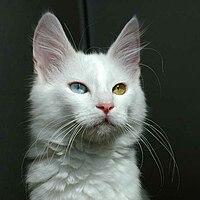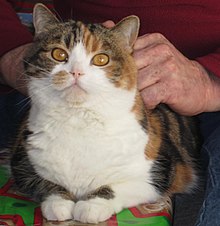
→ Back to the hub. Click Here!

Tabby male domestic short-haired cat.
A domestic short-haired cat is a cat of mixed ancestry—thus not belonging to any particular recognized cat breed—possessing a coat of short fur. In British English, they are often referred to as moggies. Domestic short-haired cats should not be confused with the British Shorthair, American Shorthair, or other standardized breeds with "Shorthair" names, which are breeds recognized by various registries. Domestic short-haireds are the most common cat in the United States,[1] accounting for around 90–95% of their number.[1][2] Other generic terms include house cat and alley cat (the latter may be used more specifically to refer to feral individuals). The term tabby cat technically refers to a coat pattern, but is also often used as a general term[citation needed] for cats of this sort.
In the cat fancy, and among veterinarian and animal control agencies, domestic short-haired cats may be classified with organisation-specific terminology (often capitalized), such as
Such a pseudo-breed is used for registry as well as shelter/rescue classification purposes. While not bred as show cats, some mixed-breed cats are actually predigreed and entered into cat shows that have non-purebred "Household Pet" divisions. Show rules vary; Fédération Internationale Féline (FIFe) permits "any eye colour, all coat colours and patterns, any coat length or texture, and any length of tail"[4] (basically, any healthy cat). Others may be more restrictive; an example from the World Cat Federation: "All classic colours are permitted. Any amount of white is permitted. The colours chocolate and cinnamon, as well as their dilution (lilac and fawn) are not recognized in any combinations (bicolour, tricolour, tabby). The pointed pattern is also not recognized. The description of colours is listed in the general list of colours."[5]
Domestic short-haired cats are characterised by a wide range of colouring, and typically "revert to type" after a few generations, which means they express their coats as a tabby cat. This can be any colour or combination of colours. They also exhibit a wide range of physical characteristics, and as a result, domestic short-haired cats in different countries tend to look different in body shape and size, as they are working from differing gene pools. DSH cats in Asia tend to have a build similar to a "classic" Siamese or Tonkinese, while European and American varieties have a thicker, heavier build.[6] Mixed-breed domestic cats have a form of hybrid vigor due to their diverse gene pool, so they are much less vulnerable to the genetic problems for which purebred cats must be carefully screened.
Since freely breeding domestic short-haired cats form distinctive landraces in wide geographic areas, they have been the basis of several recent formal breeds such as the European Shorthair (Celtic Shorthair), and American Shorthair.

A white Turkish Angora cat with odd eyes (heterochromia), which is common among the Angoras.
The Turkish Angora (Turkish: Ankara kedisi, 'Ankara cat'[1]) is a breed of domestic cat. Turkish Angoras are one of the ancient, natural breeds of cat, having originated in central Turkey, in the Ankara region. The breed has been documented as early as the 17th century and is believed to be the origin of the mutations for both the color white and long hair. The breed is also sometimes referred to as simply the Angora or Ankara cat.[1]
Like all domestic cats, Turkish Angoras descended from the African wildcat (Felis silvestris lybica). Their ancestors were among the cats that were first domesticated in the Fertile Crescent. Cats from eastern mountainous regions of Anatolia developed into longhaired breeds like the Turkish Van and the Turkish Angora through inbreeding and natural selection.
Longhaired cats were imported to Britain and France from Asia Minor, Persia and Russia as early as the late 16th century, though there are indications that they appeared in Europe as early as the 14th century due to the Crusades. The Turkish Angora was used to improve the coat on the Persian, almost to the point of extinction.[citation needed] The Turkish Angora was recognized as a distinct breed in Europe by the 17th century.[2] However, there is a strong connection between Angoras and Persians. Charles Catton, in his 1788 book Animals Drawn from Nature and Engraved in Aqua-tinta, gave "Persian cat" and "Angora cat" as alternative names for the same breed.[3]
The Persian cat was developed from Turkish angora mutations by British and American cat fanciers. Although some cat associations think the Persian cat is a natural breed, in the 19th century Persians and Angoras were identical. In 1903, F. Simpson wrote in her book The Book of the Cat:[4]
The Angora of the 20th century was used for improvement in the Persian coat, but the type has always been divergent from the Persian – particularly as the increasingly flat-faced show catPersian has been developed in the last few decades.
In the early 20th century, Ankara Zoo began a breeding program to protect and preserve pure white Angora cats.[5] The zoo particularly prized odd-eyed specimens (i.e., with one blue and one amber eye); however the cats were chosen only by their color (white)—no other criterion was used. Despite the lack of selective breeding and no consideration given for the deafness problem, Ankara Zoo cats have a very similar type.
The Turkish Angora, which was brought to Canada in 1963, was accepted as a championship pedigreed breed in 1973 by the Cat Fanciers' Association.[6] However, until 1978 only white Angoras were recognized. Today, all North American registries accept the Turkish Angora in many colors and patterns. While numbers are still relatively small, the gene pool and base of fanciers are growing.
Breeders in Turkey feel that the cat fancy’s fine-boned version of their national breed is unrepresentative of the true Turkish cats, which are much sturdier. American “Turkish” Angoras may have only a minimal remnant of the original Ankara Zoo DNA and are only “purebred on paper". [7]

Turkish Angora kitten with odd eyes.
Turkish Angora cats have long, silky coats and elegant, sinuous bodies. A younger Turkish Angora can often be mistaken for a snow weasel. Though it is known for a shimmery white coat and posh tail, Turkish Angora cats can display a variety of colors.[10] They come in taby and tabby-white, along with black with an undercoat of chocolate brown, and lastly smoke varieties, and are in every color other than those that indicate crossbreeding, such as pointed, chocolate and lavender.[11][12]
Eyes may be blue, green, amber, yellow, or heterochromatic (e.g., one blue and one amber or green). Ears are pointed, large and wide-set. The eyes are almond shaped and the profile forms two straight planes. The plumed tail is often carried upright, perpendicular to the back.[11]

Lilac coloured adult Scottish Fold, displaying round face, round eyes and forward-folded ears.
The Scottish Fold is a breed of domestic cat with a natural dominant-gene mutation that affects cartilage throughout the body, causing the ears to "fold", bending forward and down towards the front of the head, which gives the cat what is often described as an "owl-like" appearance.[1]
Originally called lop-eared or lops after the lop-eared rabbit, Scottish Fold became the breed's name in 1966.[1] Depending on registries, longhaired Scottish Folds are varyingly known as Highland Fold, Scottish Fold Longhair, Longhair Fold and Coupari.[2]
The original Scottish Fold was a white barn cat named Susie, who was found at a farm near Coupar Angus in Perthshire, Scotland, in 1961. Susie's ears had an unusual fold in their middle, making her resemble an owl. When Susie had kittens, two of them were born with folded ears, and one was acquired by William Ross, a neighbouring farmer and cat-fancier.[3] Ross registered the breed with the Governing Council of the Cat Fancy (GCCF) in the United Kingdom in 1966 and started to breed Scottish Fold kittens with the help of geneticist Pat Turner.[4] The breeding program produced 76 kittens in the first three years—42 with folded ears and 34 with straight ears. The conclusion from this was that the ear mutation is due to a simple dominant gene.[5]
Susie's only reproducing offspring was a female Fold named Sans who was also white; a second kitten was neutered shortly after birth. Three months after Sans' birth, Susie was killed by a car. All Scottish Fold cats share a common ancestry to Susie.[2]
The breed was not accepted for showing in Europe and the GCCF withdrew registrations in 1971 due to crippling deformity of the limbs and tail in some cats and concerns about genetic difficulties and ear problems such as infection, mites, and deafness, but the Folds were exported to America and the breed continued to be established using crosses with British Shorthair and American Shorthair. Since the initial concerns were brought, the Fold breed has not had the mite and infection problems, though wax buildup in the ears may be greater than in other cats.[1][2]
The rare distinctive physical traits of the breed, combined with their reputation as unusually loving companions, make Folds highly sought-after pets and Fold kittens typically cost considerably more than kittens of more common breeds.[6] Scottish folds are also popular among celebrities.
All Folds are born with straight, unfolded ears, and those with the Fold gene will begin to show the fold usually within about 21 days. The kittens that do not develop folded ears are known as Straights.[1] The original cats only had one fold in their ears, but due to selective breeding, breeders have increased the fold to a double or triple crease that causes the ear to lie totally flat against the head.

Scottish Fold with Straight ears.
The Scottish Fold is a medium-sized cat, with males typically reaching 4 to 6 kg (9–13 lb), females 2.7–4 kg (6–9 lb). The Fold's entire body structure, especially the head and face, is generally rounded, and the eyes large and round. The nose will be short with a gentle curve and the cat's body well-rounded with a padded look and medium-to-short legs. The head is domed at the top, and the neck very short. The broadly-spaced eyes give the Scottish Fold a "sweet expression".[5]
Scottish Folds can be either long- or short-haired, and they may have nearly any coat color or combination of colours (including white).[5] Short hair Scottish Folds have thick and soft fur, with long hair Folds having longer and exceptionally dense fur around their upper thighs, toes, ears, and tail.[7]
→ Back to the beginning. Click Here!